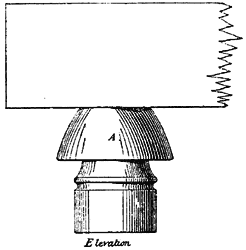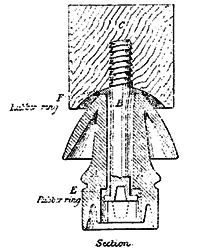[Trade Journal]
Publication: The Telegraphic Journal and Electrical Review
London, England
p. 332-333, col. 1-2
BLOOMFIELD'S PATENT INSULATOR.
This insulator, the invention of Mr. John H. Bloomfield, of Concordia, Entre Rios, Argentine Republic, is designed specially for South America, to prevent breaking, from the expansion of the iron shank, in a climate subject to sudden changes of temperature, in which it is impossible to maintain the insulation of a line in a good state without frequent renewals. Where this insulator is used, the "Hornero," a species of "Furnarius" (F. rufus)—a bird well known in South America, which, builds its nest of mud on the telegraph brackets and insulators—cannot cause "weather contact" or "earth;" on the contrary, by building its nest on the cross-arm or bracket, right over the insulator, it will improve the insulation, as its nest would be a protection in wet weather. Suspension insulators, in which the wire is hung in hooks, have this lat. advantage also ; but the wire breaks frequently the wedges, or cams, of the stretching insulator frosty weather, and runs down a long way throe the hooks. They are also heavy and expensive, a liable, in common with all others, to be broken the expansion of the hooks, hoods, or cement.
 |
| Fig. 1. |
 |
| Fig. 2. |
Fig. 1 is a side view of one of the improved insulators. Fig. 2 is a longitudinal section of the same.
A represents the insulator, which is designed be made of glass, porcelain, or glazed brown ware with a convexed upper end, a concaved lower and a downwardly-projecting cup-flange around upper part covering the part around which the wire is to be fastened. The porcelain cup, A, is perforated longitudinally to receive the screw, B, which it is secured to the lower side of the cross bar, C, attached to a pole.
The perforation is made a little larger than the body of the screw, B, so that the porcelain cannot be broken by the expansion of the screw.
The lower end of the perforation through the porcelain is countersunk to receive the head of screw, B, and the head has a square hole or cavity formed in it, in line with the axis of the screw, to receive a key for screwing it into and out of the cross-bar, C.
Upon the body of the screw, B, within the upper and lower parts of the perforation through the cup are placed two rubber bands, to fill up the space between the screw and cup, and keep the latter firm and steady.
Upon the body of the screw, B, at its head, is placed a rubber ring, E, which is made a little smaller than the head, and which, when the screw is tuner up into place, is pressed into the countersink in the porcelain, A, and around the outer edge of the screw-head, so as to cushion the screw-head and keep it from coming in contact with the porcelain cup.
Upon the screw, B, at the upper end of the porcelain, A, is placed a rubber ring, F, which, when the screw is turned up into place, is pressed into the upper end of the space between the screw and cup, and between the cup and the cross-bar, C, so as to cushion the insulator to the cross-bar.
By this construction the porcelain cup, A, is kept from contact with the screw, B, and the crossbar, C, and the screw is allowed to expand without breaking A, and to contract without loosening it.
The under side of the cross-bar, C, is concaved to receive the upper end of the cup, A, to protect it from the weather.
With this construction, should an insulator be broken a new one can be secured in place with the same rubbers and screw that secured the old one, so that the line-repairer will only have to carry a small key and a number of insulators, no nails, hammer, screw-driver, screws, &c., being necessary.
Should it be desirable to use iron-hooded insulators, the "South American" can be made so, by placing a perforated inverted iron cup on the screw between the caoutchouc ring and the cross-arm or bracket; this gives all the advantages of the ordinary iron-hooded insulator, with none of its drawbacks.
The loss and waste of material is less with this insulator than with any other, as the parts are interchangeable, the screw and rings of one answering for the porcelain cup of another. This is an important consideration in ordering supplies for renewals, as only the parts required need he ordered, thus reducing the expense of maintenance and freight.
Where a wire is broken it often runs down from three or four poles on each side of the break, tearing off or breaking the insulators, and loosening the posts. A good deal of this would be avoided with the new invention, as, owing to the caoutchouc rings, each insulator acts as a spring, and lessens the shock.
Experience has shown that if a telegraph line is examined a month after it has been put in repair, particularly if there have been any frosty nights, allowed by warm days, a good many insulators sill be found cracked, loose, or with incipient tracks, showing that their efficiency as insulators is very much impaired; and if the lineman does his duty, he should carry a number of insulators with him, depending on the length of his line, every time he patrols it. With the above insulator hi this would be avoided, as the insulator cannot be injured by the expansion of the screw. If this insulator were to get broken, the wire would not drop to the ground unless the porcelain was broken piecemeal, because the binding wire will keep the pieces together, and the head of the screw being underneath prevents them from slipping down.
